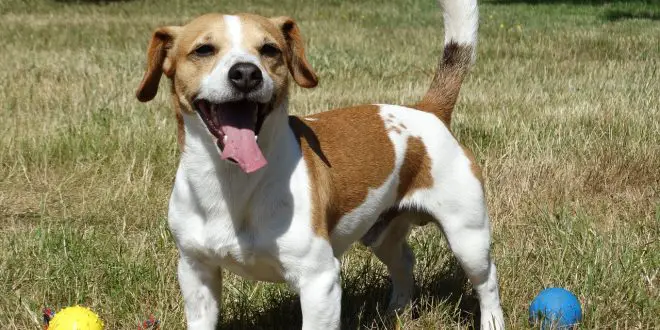Here on HJR we’re all about positive training techniques and one of the best is today’s subject – clicker training.
This is a method of learning by operant conditioning – you will help your puppy start behaving a certain way by reinforcing the positive consequences of his actions.
If your pet is doing the right thing, it will be rewarded with a tasty treat preceded by a clicking sound that will after some time become associated with good things to come. Sounds simple but there’s a lot more to it.
The greatest advantage of clicker training comes from the fact that it works much faster than traditional training methods, and this is true for dogs of all ages.
The amazing thing is that you can train a great variety of animals using this approach, including marine mammals. It’s even been proven as a useful mnemonic tool for humans too.
What is a clicker?
A clicker is a simple device that consists of a thin piece of torqued metal or plastic that produces a clicking sound when pressed. Although it seems almost ridiculously simple, this mechanism will help you achieve tremendous results.
There are two things that you have to look for when buying a clicker. The first is ergonomics – it should be small, lightweight, fit nicely into your hand, and have an easy, straightforward and comfortable mechanism (usually a button) that you can use at a moments notice.
Having some way to attach it to your belt, key chain or the leash handle, like with the excellent StarMark Clicker Dog Training System, will make it even easier for you. Not to mention that that way you won’t accidentally drop or forget it somewhere. The second thing you should watch out for is the sound it produces.
There are various products on the market with different clicking sounds – some are louder and sharper, some are softer and quieter.
The kind you choose will ultimately depend on your pet’s reaction. They have to be comfortable with the sound yet be able to distinguish it from all the background noise so they can become attentive and react to it when they hear it.
You can try wrapping some cloth, for instance, a towel, around your clicking hand to modify and muffle the sound. Some dogs can even be scared of the clicking noise – if you don’t find any clickers that suit them you shouldn’t force clicker training and instead practice other positive training techniques.
Charging the clicker
The clicker has a role of an event marker. In other words, the short, snappy sound that it produces will be an instant signal that your dog is doing a good thing worthy of a reward. Therefore before you can commence training your dog must start associating the clicking sound with pleasure and, as we all know, there is nothing better than a delicious treat.
Start by holding the clicker in one hand, and a high value treats in the other. Click and then give a treat to your pet. Do not offer them the treat at the same time nor before the click. We want them to associate the click with good things to come.
Do this in short sessions of a few minutes 2-3 times a day for a few days. After a short while, you’ll notice that they started to pay more attention to the clicking and expect a reward after the sound. Repeat the process in different environments so that they know that the click means they get a prize wherever you currently are – be it at home, on the street, on the beach or in a park.
All-important treats
During your training sessions, you’ll use a lot of treats so remember to use only small parcels (the size of a pea) and consider them a part of your pet’s regular meal. This way you don’t have to worry about them gaining weight or losing appetite from all that yummy goodness.
Use only treats that your four-legged buddy can swallow quickly and easily without chewing. This is crucial because you don’t want them to lose concentration by having a feast. For instance, soft and savory Zuke’s Mini Naturals Dog Treats are perfect for the task.
Remember to use only products that are 100% natural without any artificial flavors and preservatives, and if your trusty companion likes that crunchy goodness, you can’t miss with the awesome Wilderness Blue Buffalo Dog Treats and Natural Balance Limited Ingredient Dog Treats.
Pre-made treats that are too big for a quick chomp, like the premium Rocco & Roxie Gourmet Jerky Dog Treats, just cut up into tiny pieces and you’re ready to go.
For all you jerky lovers out there is also the fantastic bite-sized ZiwiPeak Air-Dried Dog Treats – my darling JRT Kala simply adores them.
Save yourself a lot of trouble – get a treat pouch
All those bits of treats can be quite messy and awkward to handle, so I wholeheartedly recommend using treat bags like the excellent Outward Hound Hands-Free Storage For Treats, Balls & Training Accessories.
They are an awesome way to store and carry snacks and treats for our beloved furry companions without having to worry about the mess in our pockets and dealing with unpractical plastic bags.
Treat pouches will keep the treats fresh and you can easily clip them on your belt or wherever else you find them most practical.
PetSafe Treat Pouch Sport even has additional pockets and a key ring to store your smartphone, clicker and other trinkets that you may need during your training sessions.
Marking the behavior
Once your pet is accustomed to the clicker and understands exactly what it means, i.e. being rewarded, it’s time to start implementing it in your training regime. For clicker training to work you have to be observant and have good reflexes. You have to react within 1,5 seconds since the desired action for your dog to correctly understand which behavior he is rewarded for.
This is a training technique that motivates your pet to know which behavior will earn them a prize intuitively. The significant advantage over training with only verbal commands is that they will know exactly the moment that they’ve done something right which will able you to divide the learning process into smaller, easier units.
For example: if you want to train them to sit you can have an “informal” training exercise. Every time you catch them sitting down just say the short and clear verbal cue that you chose for the action (for instance “Sit”) then immediately use the clicker and give them a treat.
Soon they will start to associate the sounds: “Sit”, with the act of sitting and the pleasurable reward that they get for doing the deed. When you think that they understand the meaning of the word start the training properly – say the word “Sit” while they are standing up and as soon as they touch the ground with their backsides mark the action with a clicker and give them a treat.
If you wish to repeat the exercise and with time, when you think that they are on cue, faze out the treats for a start and then the clicker.
It’s better not to click at all then to click too late. That way you’ll avoid confusing him and potentially reinforce unwanted behavior.
Shaping behavior
As I mentioned earlier, clicker training allows you to guide your pet step by step through the training process. They’ll want to explore, modify and perfect tasks that earn them their treats. The whole method is based on their willingness to explore and change their behavior in a way that pleases you, and consequentially them.
When changing your pet’s behavior using clicker training, you must concentrate on rewarding the desired and ignoring the undesired. For instance, if you’re dog is barking a lot you could use the clicker to establish a connection between long periods of silence and rewards.
With time your pet’s traits that you encouraged will flourish while those that you ignored will become rarer and might disappear altogether without resorting to punishment that causes more problems than it will solve.
Why does it work?
At a basic level, our pet’s brains aren’t developed to understand all nuances and intricacies of human speech, just as we aren’t developed to understand their barks.
Contrary to our words clicks are a simple yet highly distinctive and momentary auditory cue that relay one crucial information: “This, what you are doing, is good. Keep it up!”
The treat with which you reinforce their behavior doesn’t even have to be food, although it’s the most effective. It can be a cheerful: “That’s a good boy!”, a rub on the belly or their favorite squeaky toy – whatever makes them happy, so they want to do it again, and do it even better than before.
For a more in-depth look at method as a whole and a bunch of great tips to make it an even more pleasurable and meaningful experience for both you and your furry darling I wholeheartedly recommend that you read the comprehensive Reaching the Animal Mind: Clicker Training and What It Teaches Us About All Animals.
This great book is written by no other than the godmother of clicker training Karen Pryor – who has perfected it since the 1970s. There’s also her excellent Getting Started: Clicker Training for Dogs Kit where you’ll find everything you need to get started in one practical bundle.
This method is an incredible example of how we can achieve great results with all around positive approach to our pooches. Try it out, and I’m sure you’ll have an excellent time. Just looking at the unbelievably cute face of my beautiful Jack Russell Terrier Kala when she tries to guess what exactly is that great thing that she did that put the yummy in her tummy brightens up my whole day. It’s awesome!
We’d like to hear more about your clicker training experiences in the comments below.
 Happy Jack Russell Everything about Jack Russell Terriers
Happy Jack Russell Everything about Jack Russell Terriers




